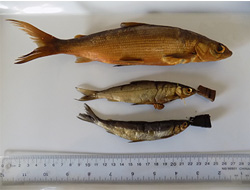Lake Whitefish (Opeongo Lake large and small-bodied populations)
Scientific name: Coregonus clupeaformis

Photo credit: N.E. Mandrak
Status
Threatened
“Threatened” means the species lives in the wild in Ontario, is not endangered, but is likely to become endangered if steps are not taken to address factors threatening it.
Date added to the Species at Risk in Ontario List
January 26, 2022
Read the assessment report (PDF)
What it looks like
Lake Whitefish is a cool water fish that averages about 30 cm in length and can typically weigh 0.9 to 1.8 kilograms. This fish has a greenish-brown back, with silvery sides and a silver-white belly. It is a slightly deep-bodied fish with a deeply forked tail and a snout that overhangs its mouth.
Where it lives
Lake Whitefish typically prefers the deep sections of large lakes, acting mainly as a bottom feeder, eating crustaceans, snails, insects and other small aquatic organisms. Lake Whitefish will move into rivers and streams to feed in the early spring and in the fall and early winter will move to shoals of large lakes and rivers.
In some lakes, Lake Whitefish have co-evolved as species pairs with two distinct populations of larger and smaller-bodied individuals. These two populations are distinct in appearance and occupy different habitats but are not considered to be different species. The small-bodied population often occupies surface waters, while the large-bodied population are often found near the bottom of the lake.
Lake Whitefish is broadly distributed throughout Canada and Alaska, south into New England, the Great Lakes basin and central Minnesota.
Where it’s been found in Ontario
The Opeongo Lake populations of Lake Whitefish are found exclusively in Opeongo Lake, which is located in Algonquin Provincial Park.
What threatens it
The populations of Lake Whitefish found in Opeongo Lake (Opeongo Lake small-bodied and large-bodied populations) occur in a single location, which makes this local population vulnerable to extinction. Invasive aquatic species pose a threat to these populations, as well as competition from the native Cisco (C. artedi). Cisco was introduced to Opeongo Lake in 1948 to promote the growth of Lake Trout. This introduction likely contributed to the decline of the small-bodied population of Lake Whitefish in Opeongo Lake, as Cisco and small-bodied Lake Whitefish have similar niches and do not typically co-exist.
Climate change could also pose a threat to Lake Whitefish populations in Opeongo Lake through landscape and habitat changes and increases in severe weather (drought, heavy rains, extreme temperatures). Other potential threats to the species, such as pollution, forestry and motorized boating are well managed in Algonquin Provincial Park.
Action we are taking
Threatened species and their habitat is protected under Ontario’s Endangered Species Act, 2007 (ESA).
Given the two forms of Lake Whitefish in Opeongo Lake are classified as Threatened and protected under the ESA, the fishing season for Lake Whitefish in Opeongo Lake has closed.
Recovery strategy
A recovery strategy advises the ministry on ways to ensure healthy numbers of the species return to Ontario.
Read the executive summary and the full document (January 16, 2024).
Government response statement
A government response statement outlines the actions the government intends to take or support to help recover the species.
Read the government response statement (December 20, 2024).
What you can do
Report a sighting
Submit your observations of species at risk to the Natural Heritage Information Centre (NHIC), which is Ontario’s conservation data centre. Join the “(NHIC) Rare Species of Ontario” project in iNaturalist to make submitting your observations quick and easy.
Volunteer
Volunteer with species at risk programs, such as community science surveys, through your local nature club, a provincial park or other conservation organizations.
Be a good steward
- Individuals, communities and organizations across the province who undertake stewardship or research activities that benefit species at risk and their habitats may be eligible to receive funding through the Species at Risk Stewardship Program (SARSP). The SARSP was created to encourage people to get involved in protecting and recovering species at risk in Ontario through stewardship actions.
- Invasive species seriously threaten many of Ontario’s species at risk. To learn what you can do to help reduce the threat of invasive species, visit:
Report illegal activity
Report any illegal activity related to species at risk to
Quick facts
- Lake Whitefish is a cool water fish that averages about 30 cm in length and is distributed across much of Canada.
- The Opeongo Lake small-bodied and large-bodied populations of Lake Whitefish are native to Ontario, having evolved in Opeongo Lake, which is located in Algonquin Provincial Park.
- The Opeongo Lake small-bodied and large-bodied populations of Lake Whitefish spawn around late October.